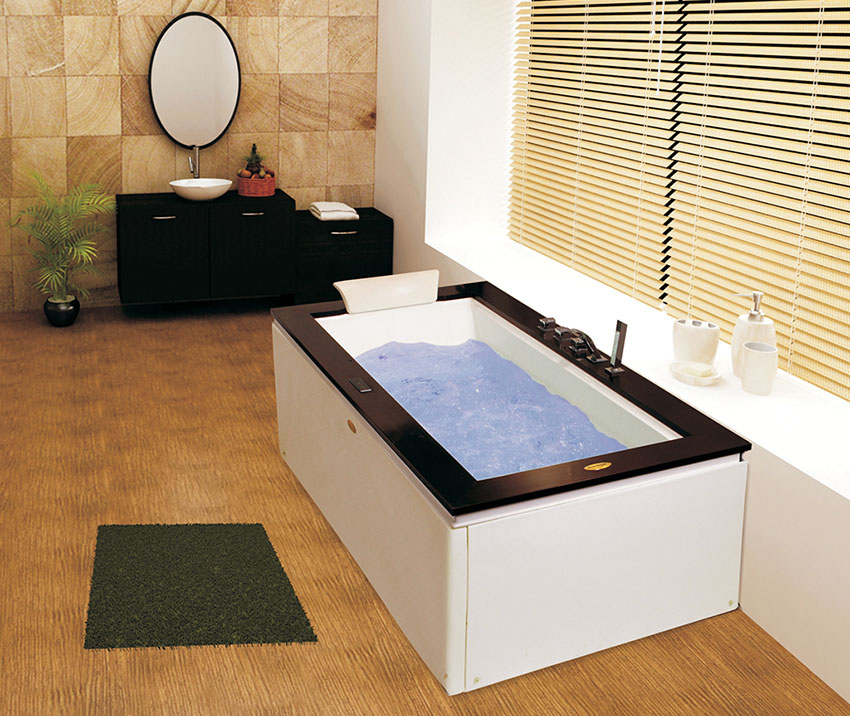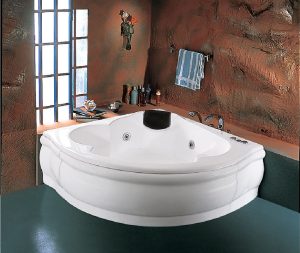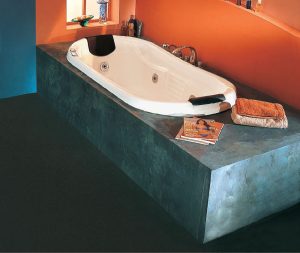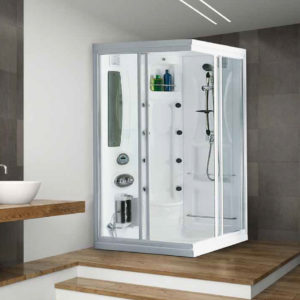Are you dreaming of a luxurious bathroom makeover? A round freestanding tub can be the perfect centerpiece to create that spa-like atmosphere you’ve always wanted. But with so many materials to choose from, how do you know which one is right for your home? In this guide, we’ll take a closer look at the most popular materials for round freestanding tubs – acrylic, cast iron, and stone. We’ll explore their pros and cons to help you make the best choice for your bathroom renovation.
Acrylic Round Freestanding Tubs: Light and Versatile
Let’s start with acrylic, one of the most popular materials for round freestanding tubs. Acrylic tubs are made from a type of plastic that’s molded into shape and reinforced with fiberglass for added strength. These tubs have a lot going for them, which is why they’re such a common choice for homeowners.
One of the biggest advantages of acrylic tubs is their weight. They’re much lighter than cast iron or stone tubs, which makes them easier to install and move around if needed. This can be a real plus if you’re renovating an older home or an upper-floor bathroom where weight might be a concern. The lightweight nature of acrylic also means you won’t need to reinforce your floor, saving you time and money on your renovation project.
Acrylic tubs are also known for their warmth. Unlike some materials that can feel cold to the touch, acrylic warms up quickly and retains heat well. This means your bathwater will stay warmer for longer, allowing you to enjoy a more relaxing soak. The smooth surface of acrylic is also very comfortable against your skin, adding to the overall bathing experience.
When it comes to looks, acrylic tubs offer a lot of versatility. They come in a wide range of colors and finishes, so you can easily find one that matches your bathroom decor. Whether you want a classic white tub or something more bold and colorful, there’s likely an acrylic option out there for you. The material can also be molded into various shapes and designs, giving you more style options to choose from.
Durability is another strong point for acrylic tubs. They’re resistant to chips, cracks, and fading, which means they can maintain their good looks for years to come. If any minor scratches do occur, they can often be buffed out easily. Acrylic is also non-porous, which makes it naturally resistant to mold and mildew growth – a big plus for keeping your bathroom clean and hygienic.
Cleaning an acrylic tub is usually pretty straightforward. The smooth surface doesn’t tend to hold onto dirt and grime, so a quick wipe-down with a mild cleaner is often all that’s needed to keep it looking great. This can be a real time-saver in your cleaning routine.
However, like any material, acrylic does have a few drawbacks to consider. While it’s durable, it’s not completely scratch-proof. Harsh scrubbing or abrasive cleaners can leave marks on the surface, so you’ll need to be a bit careful with your cleaning methods. Some people also feel that acrylic tubs don’t have quite the same luxury feel as heavier materials like cast iron or stone.
Price-wise, acrylic tubs are generally in the mid-range. They’re typically more affordable than cast iron or stone options, but pricier than basic built-in tubs. This makes them a good choice for homeowners who want to upgrade their bathroom without breaking the bank.
Cast Iron Round Freestanding Tubs: Classic and Durable
Next up, let’s talk about cast iron tubs. These tubs have been around for a long time, and for good reason. They’re known for their classic look and incredible durability, making them a favorite for many homeowners who want a tub that will stand the test of time.
Cast iron tubs are made by pouring molten iron into a mold, then coating it with a layer of enamel. This results in a tub that’s extremely strong and long-lasting. In fact, with proper care, a cast iron tub can last for decades – even up to 100 years! This makes them a great choice if you’re looking for a tub that you won’t need to replace anytime soon.
One of the standout features of cast iron tubs is their heat retention. The iron core of these tubs absorbs heat from your bathwater and then slowly releases it back, keeping your bath warmer for longer. This can make for a more enjoyable and relaxing bathing experience, especially on chilly days.
When it comes to looks, cast iron tubs have a timeless appeal. They often have a classic, vintage appearance that can add a touch of elegance to any bathroom. While they’re most commonly found in white, you can also find cast iron tubs in other colors to suit your decor preferences.
Durability is where cast iron tubs really shine. The enamel coating is extremely tough and resistant to chips, scratches, and stains. Even if the enamel does get damaged, it can often be repaired, unlike some other tub materials. This durability means your tub can keep looking great for years, even with regular use.
Cleaning a cast iron tub is usually pretty simple. The smooth, non-porous enamel surface doesn’t hold onto dirt or provide a good environment for mold and mildew growth. A gentle cleaner and soft cloth are typically all you need to keep your tub looking pristine.
However, there are a few potential downsides to consider with cast iron tubs. The biggest one is their weight. Cast iron tubs are very heavy, which can make installation tricky. You may need to reinforce your floor to support the weight, especially in older homes or upper-floor bathrooms. This can add to the overall cost and complexity of your renovation project.
The weight of cast iron tubs also means they’re not easy to move once they’re installed. If you like to change up your bathroom layout frequently, this lack of flexibility might be a drawback.
Another point to consider is that cast iron tubs can feel cold to the touch, especially when you first get in. While they retain heat well once they warm up, that initial chill can be a bit of a shock.
Price-wise, cast iron tubs tend to be on the higher end of the scale. They’re often more expensive than acrylic options, reflecting their durability and classic appeal. However, many homeowners feel the longevity of these tubs makes them a worthwhile investment.
Stone Round Freestanding Tubs: Luxury and Uniqueness
Last but certainly not least, let’s explore stone round freestanding tubs. These tubs are often considered the pinnacle of luxury in bathroom design, offering a unique and high-end bathing experience.
Stone tubs can be made from various types of natural stone, including marble, granite, limestone, and onyx. Each piece of stone is unique, with its own patterns and coloration, which means your tub will truly be one-of-a-kind. This natural beauty can make a stone tub the focal point of your bathroom, creating a stunning visual impact.
One of the biggest draws of stone tubs is their luxurious feel. There’s something special about bathing in a tub carved from natural stone. It can create a sense of connection with nature and add a spa-like atmosphere to your bathroom. The cool, smooth surface of stone can be very soothing and comfortable against your skin.
Stone tubs are also known for their excellent heat retention properties. Like cast iron, stone absorbs heat from your bathwater and slowly releases it back, helping to keep your bath warm for longer. This can make for a more relaxing and enjoyable bathing experience.
Durability is another strong point for stone tubs. Natural stone is incredibly hard-wearing and can last for generations with proper care. It’s resistant to scratches and chips, and unlike some materials, it tends to look better with age as it develops a natural patina.
When it comes to style, stone tubs offer a lot of variety. Different types of stone have different looks, from the classic elegance of marble to the rustic charm of granite. You can also find stone tubs in various shapes and sizes, allowing you to choose one that perfectly fits your bathroom’s style and dimensions.
Cleaning a stone tub is generally straightforward, but it does require some special care. You’ll need to use gentle, non-acidic cleaners to protect the stone’s surface. Some types of stone may also need periodic sealing to prevent staining and maintain their appearance.
However, there are a few potential drawbacks to consider with stone tubs. Like cast iron, stone tubs are very heavy. This means you may need to reinforce your floor to support the weight, which can add to your renovation costs. The weight also makes stone tubs difficult to move once they’re installed, so you’ll want to be sure about your bathroom layout before committing.
Another point to consider is that stone can feel quite cold to the touch, especially in cooler weather. While it warms up and retains heat well once filled with hot water, that initial chill can be a bit of a shock.
Stone tubs also tend to be the most expensive option among round freestanding tubs. The cost reflects the unique nature of each tub and the craftsmanship involved in creating them. While many homeowners feel the luxury and longevity of a stone tub justify the price, it may not fit everyone’s budget.
Lastly, some types of stone can be somewhat porous, which means they might be more prone to staining if not properly sealed and maintained. This is something to keep in mind if you’re considering a lighter-colored stone tub.
Choosing the Right Material for Your Home
Now that we’ve looked at the pros and cons of acrylic, cast iron, and stone round freestanding tubs, how do you choose the right one for your home? Here are a few key factors to consider:
Budget: Your budget will play a big role in your decision. Acrylic tubs are generally the most affordable, while stone tubs are typically the most expensive. Cast iron falls somewhere in the middle.
Weight considerations: If you’re renovating an older home or an upper-floor bathroom, the weight of your tub matters. Acrylic tubs are the lightest option, while cast iron and stone are much heavier and may require floor reinforcement.
Durability: All these materials are durable, but cast iron and stone tend to last the longest. If you want a tub that will last for decades, these might be your best bet.
Heat retention: If you love long, hot baths, consider cast iron or stone for their excellent heat retention properties. Acrylic is also good at keeping water warm, but not quite to the same degree.
Style preferences: Think about the look you want for your bathroom. Acrylic offers the most color options, cast iron has a classic appeal, and stone provides a unique, luxury feel.
Maintenance: Consider how much time and effort you’re willing to put into maintaining your tub. Acrylic is generally the easiest to clean and maintain, while stone may require more careful handling.
Remember, there’s no one-size-fits-all answer. The best tub for you depends on your specific needs, preferences, and circumstances. Take your time to weigh the pros and cons of each material, and don’t hesitate to ask for samples or visit showrooms to get a feel for the different options.
A round freestanding tub can be a beautiful and relaxing addition to your bathroom, no matter which material you choose. Whether you opt for the versatility of acrylic, the classic durability of cast iron, or the luxury of stone, your new tub is sure to provide years of bathing enjoyment. Happy renovating!




